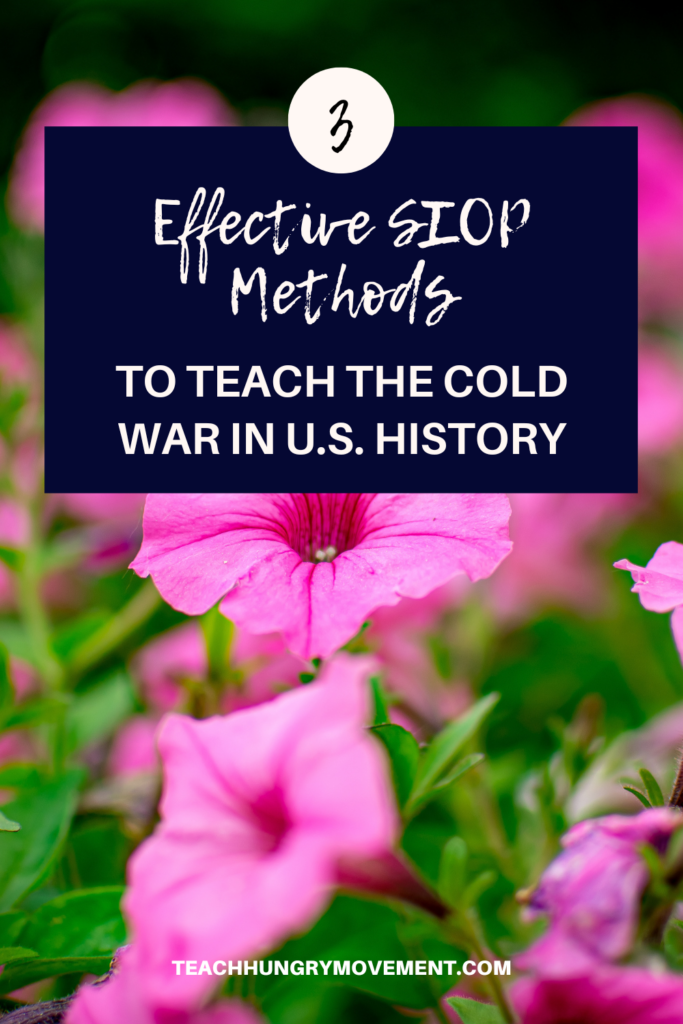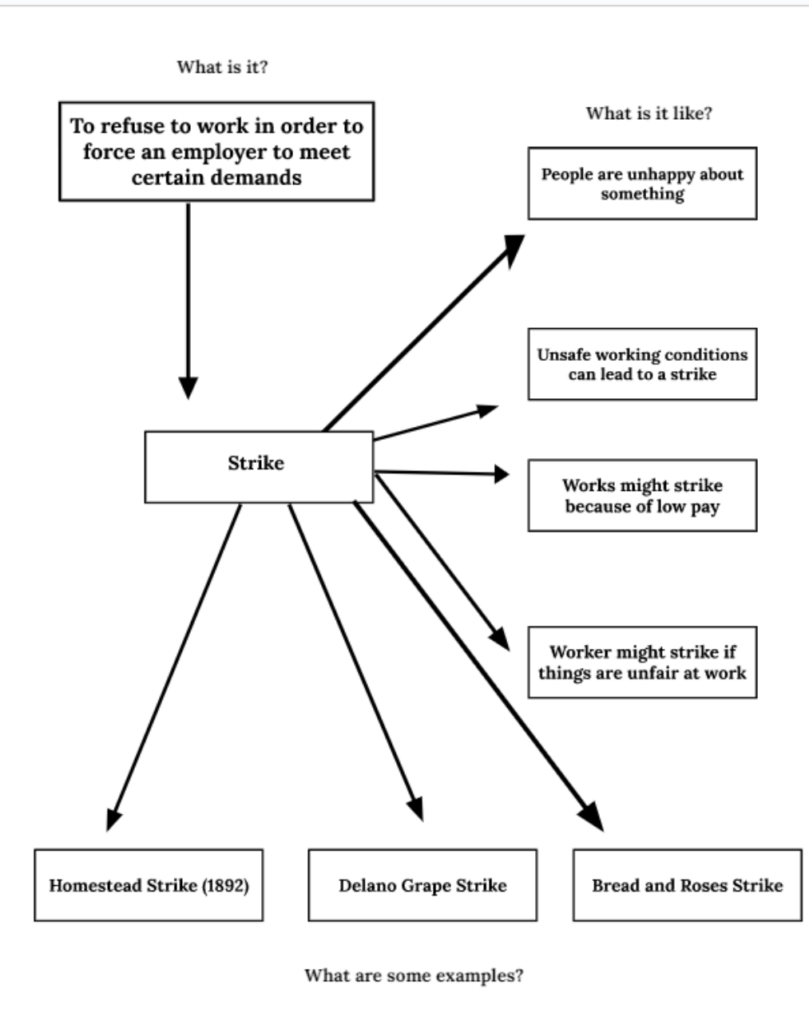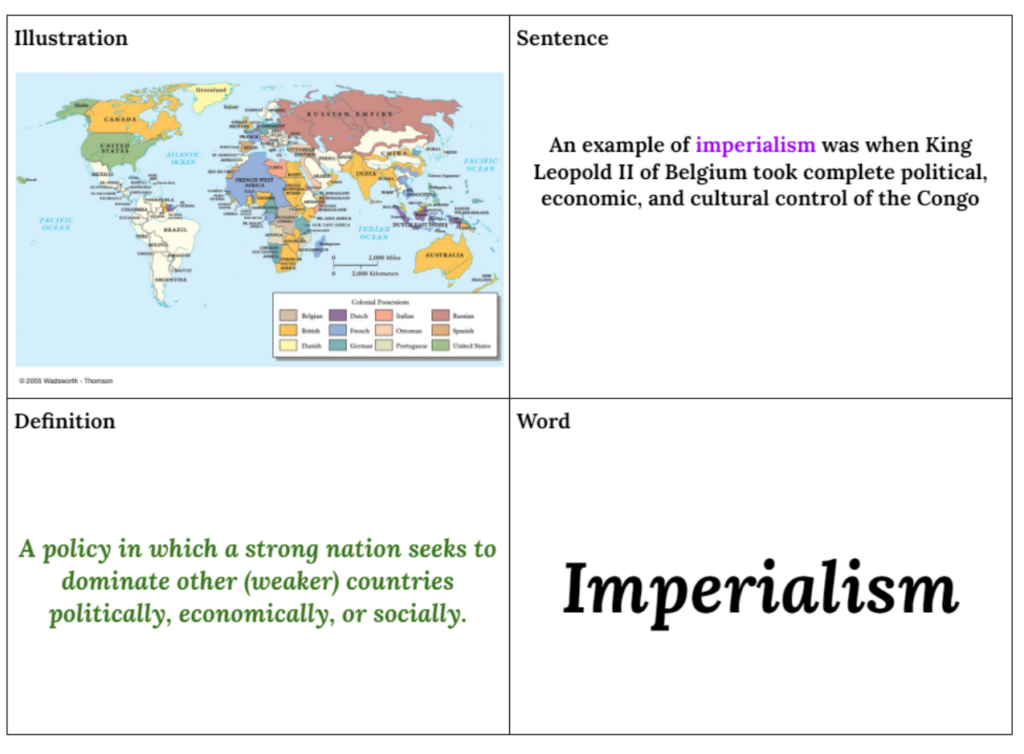Teaching high school students about the Cold War in the United States can be interesting. But it can be challenging, especially for English Language Learners.
There’s good news, though!
Use the Sheltered Instruction Observation Protocol (SIOP) strategies. These strategies ensure meaningful learning experiences for English Language Learners. They also promote their language development.
Let’s look at ways to create a SIOP lesson plan in a unit about the Cold War in U.S. History. The three SIOP strategies we will explore help engage and support ELLs in this topic.

What is the SIOP Model?
The SIOP model is a framework designed to support ELLs in content-area classrooms. It provides research-based instructional strategies to make academic content more accessible to ELLs. While promoting language development. It was developed by Jana Echevarria, MaryEllen Vogt, and Deborah J. Short. A SIOP lesson plan will help you seamlessly meet the needs of your ELLs.
SIOP Strategy 1: Building Background Knowledge
It’s important to make the topic accessible and relevant to ELLs. You can do this by activating their prior knowledge. This is called “building background” in the SIOP model.
One way to do this is to begin the lesson by engaging students in a pre-reading activity. Have your students brainstorm and discuss their understanding of the terms:
- Cold War
- Soviet Union
- communism
If your U.S. History course comes after World History, remind students they already learned about the Cold War.
Provide visual aids, such as maps and images, to aid comprehension. Next, give a short presentation highlighting key events and figures of the Cold War era. This allows students to grasp the historical context effectively.
Another strategy to help build background knowledge is using a KWL chart. This assesses students’ prior knowledge and generates interest in the subject matter. Encourage students to share their ideas and questions about the Cold War. This promotes a collaborative learning environment and helps your ELLs practice speaking English.
SIOP Lesson Plan Integration:
Introduce the Cold War through a short video showcasing key events and tensions between the United States and the Soviet Union. Then, have a class discussion using the KWL chart you had the students fill out. This will elicit students’ prior knowledge and their inquiries about the topic. This strategy activates students’ background knowledge and fosters critical thinking and engagement.
You could also begin the lesson by using a pre-reading activity about the Cold War. This will help activate students’ prior knowledge about the Cold War. Provide visual aids, such as maps and images, to aid comprehension.
SIOP Strategy 2: Comprehensible Input
Comprehensible input supports ELLs’ understanding and language development. Comprehensible input is the measurement of how easily someone can understand something.
Break down complex texts and primary sources into manageable chunks. You can use graphic organizers, such as a timeline or a Venn diagram, to help students organize their thoughts and make connections. My favorite thing to do is to incorporate vocabulary instruction. You can use a word wall displaying relevant terms and their definitions.
SIOP Lesson Plan Integration:
Two of my favorite vocab ideas are:
- Vocabulary Concept Map:
- This strategy helps students make several connections to the vocabulary term.

- Vocabulary Four Corners Chart:
- The corners include the following:
- Terms, definitions, sentences, and images (screenshot an example).
- The corners include the following:

(Grab my free lesson bundle to get a template of the Vocabulary Concept Map).
Here are some vocab words that would work well for a U.S. History unit on the Cold War:
- Cold War
- Truman Doctrine
- Containment
- Marshall Plan
- NATO
- Warsaw Pact
- Domino Theory
- Brinkmanship
- Red Scare
- The Draft
I like to keep the number of vocab words to 10 to stay manageable for the students.
You can also incorporate group activities such as
- jigsaw readings
- think-pair-share exercises
These activities allow students to work together, share their understanding, and deepen their comprehension of the material.
Once students have a solid foundation of the Cold War, it’s time to delve into key events.
Focus on significant events such as the
- Cuban Missile Crisis,
- Korean War,
- Vietnam War,
- Space Race.
SIOP Strategy 3: Hands-On Learning
Engaging students in hands-on learning experiences allow for active participation. It also creates a deep understanding of historical concepts.
Hands-on learning allows for active participation and a deep understanding of historical concepts. One way you can include hands-on learning in your class is by dividing students into small groups.
Assign each group a specific event or theme related to the Cold War, such as the Cuban Missile Crisis, McCarthyism, or the Korean War.
Provide primary source documents, news articles, or multimedia clips. Then have students analyze and explore the resources. Students then create a visual representation, such as a poster or a timeline about the topic. Encourage students to present their findings to the class. This promotes collaboration and oral language skills.
SIOP Lesson Plan Integration
Here’s an idea for an activity about the Vietnam War. This is one of my all-time favorite strategies from my discussion of Vietnam in the Cold War Unit.
On the unit’s first day, I have the students participate in a carousel activity.
In that activity, students answer questions on chart paper. They answer the questions based on their opinions.
The questions are general but related to the Vietnam War (you could do this for any war). Then, throughout the lesson, we return to the questions, discuss what the students wrote, and connect them to the Vietnam War.
Here are the questions I use:
- Do we have to help our allies by sending troops when they’re in trouble?
- If the United States starts the draft again, would you go to war, or would you accept the consequences of leaving the country or going to prison?
- Would your opinion of war change if you saw war footage on the Nightly News every evening?
- Should the president be able to send troops wherever and whenever he wants?
- If we know that we aren’t going to win, should we continue fighting?
- Is chemical warfare ever ok?
- Do protests work?
- In times of war outside the U.S., should we turn the war over to the locals?
- How would you react if you found out that a group of American soldiers killed a village of civilians, mainly women, and children, and covered it up?
- Do we have to help local civilians if they help us in wars outside the United States?
- How should we treat war veterans?
There you have it!
Using these strategies in your SIOP lesson plan on the Cold War in the United States will enhance the learning experience for ELLs. Building background knowledge, providing comprehensible input, and hands-on learning help create an inclusive and interactive classroom environment. It also supports language development while fostering a deep understanding of historical events.
Did you enjoy this post? Check out my post, 5 Effective Strategies for Teaching Social Studies to English Language Learners for more ideas!
Don’t forget to Grab my 5 Foolproof Strategies to Support ELs in Your Social Studies Classes lesson bundle. It’s chock full of some of the strategies discussed in this post.
[…] you enjoy this post? Check out my post, 3 Effective SIOP Methods To Teach The Cold War In U.S. History, for more […]